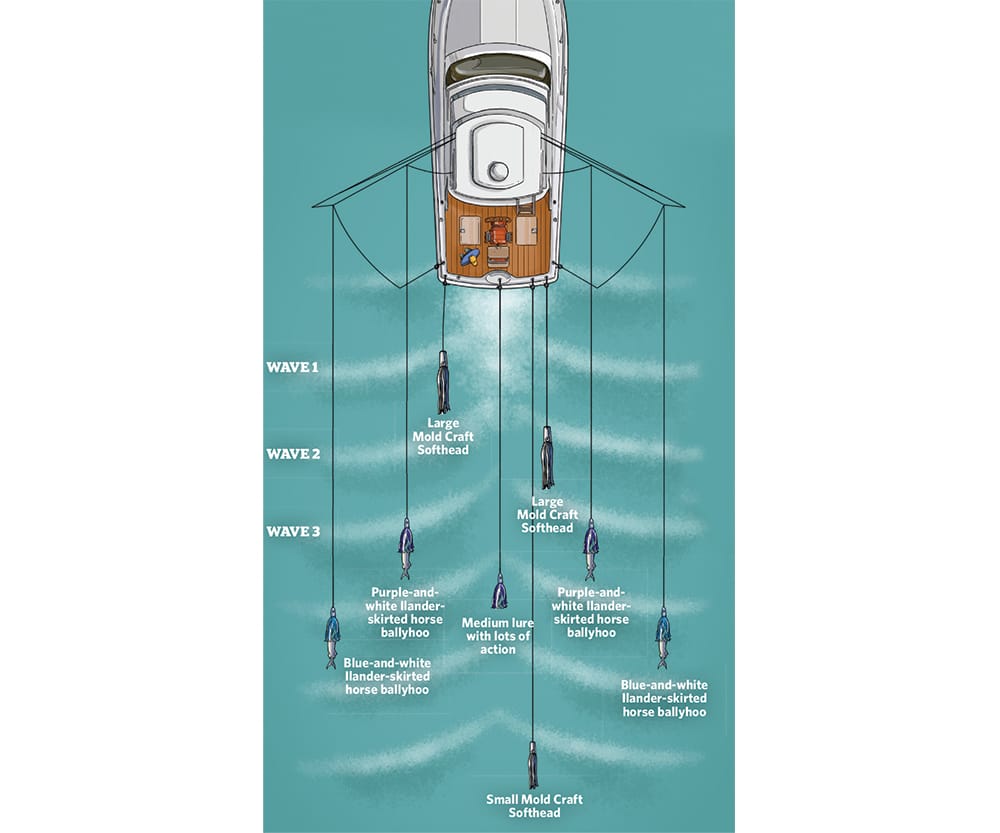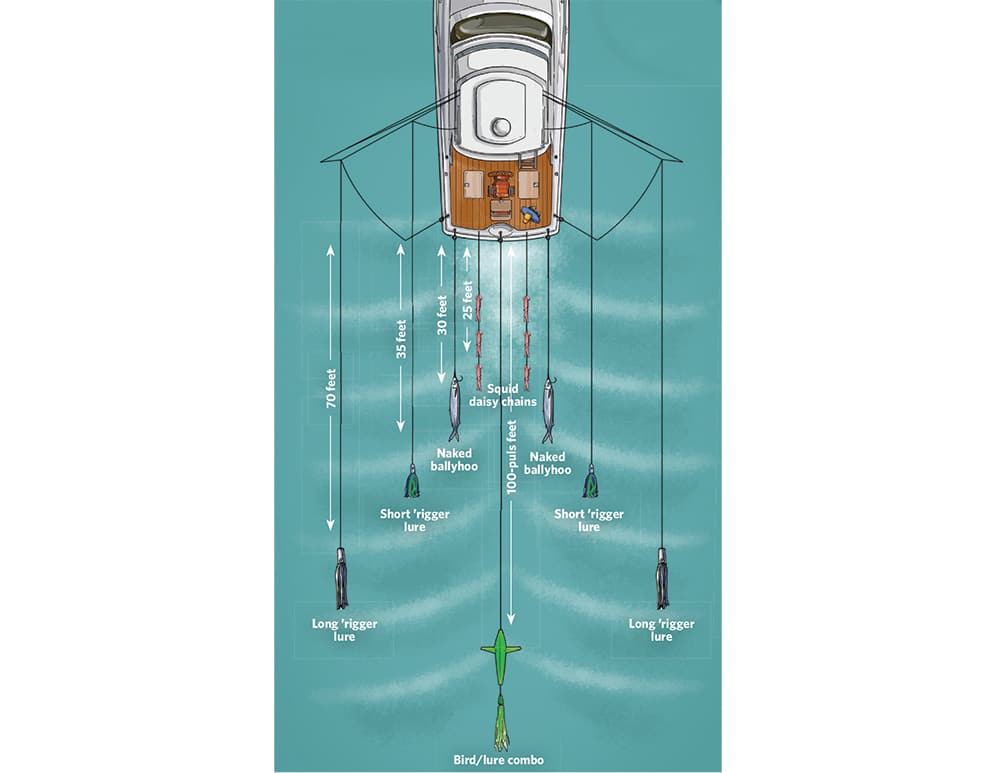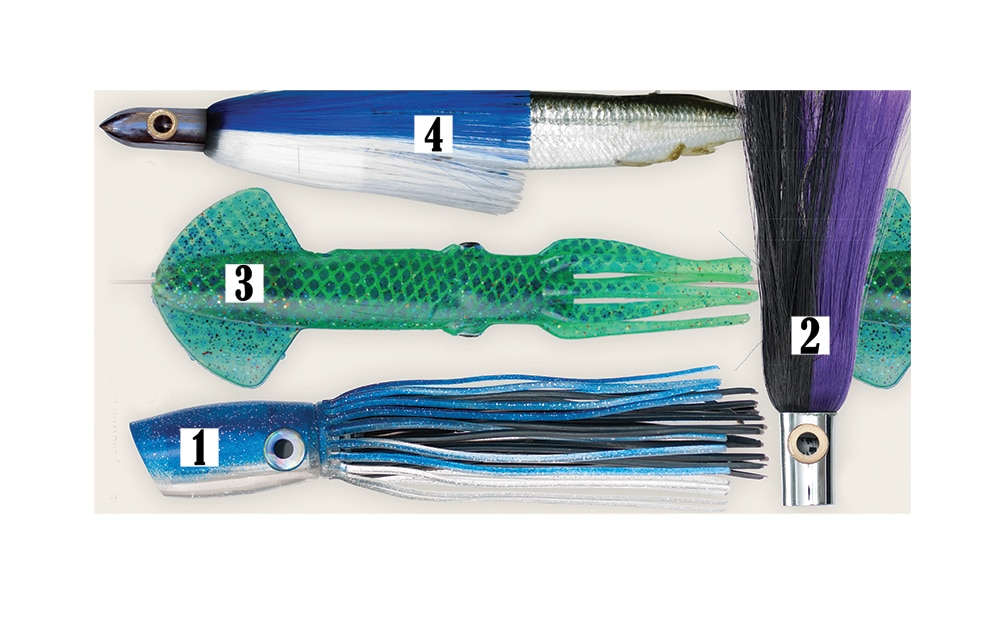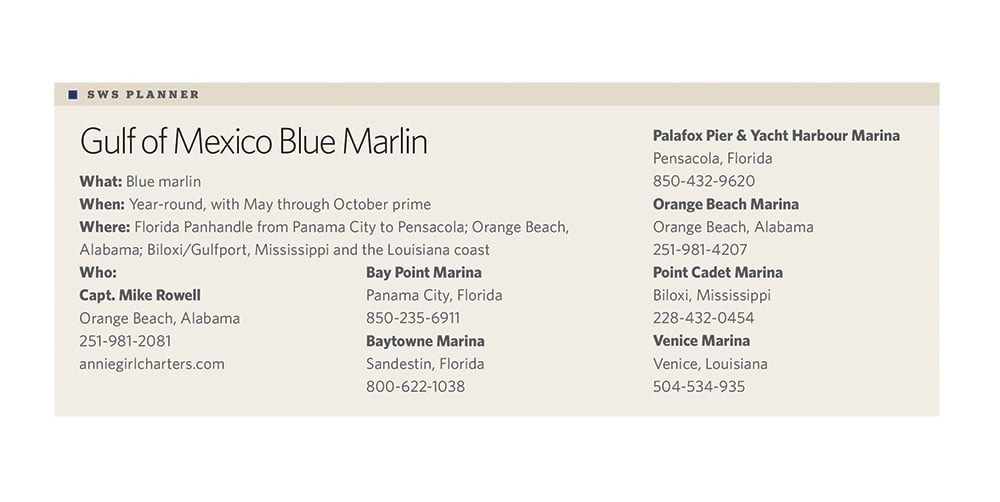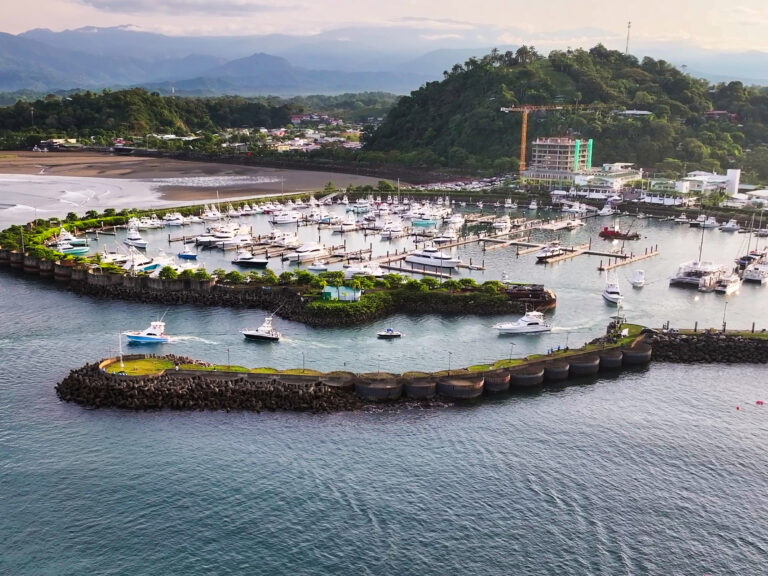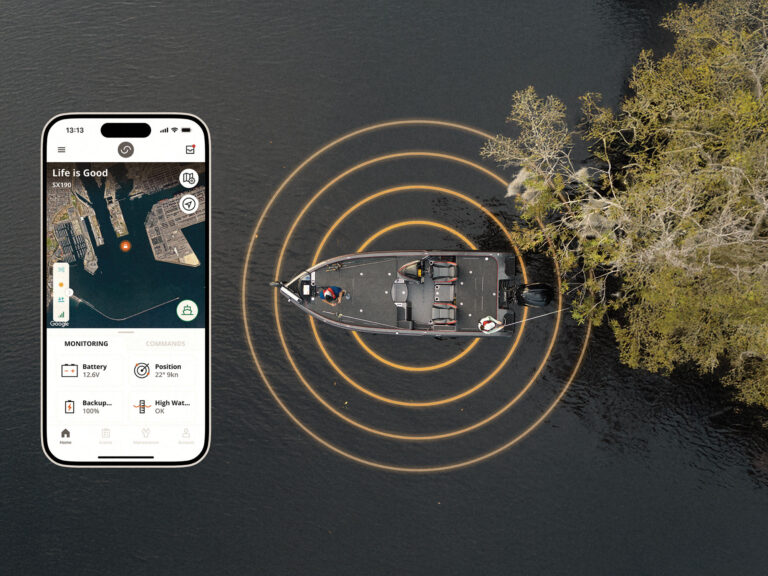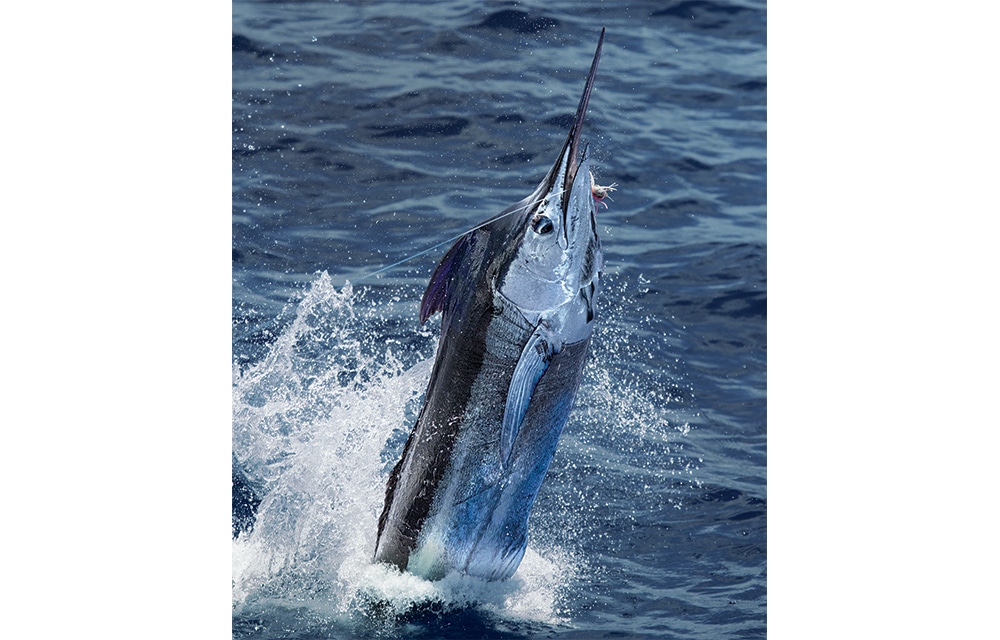
Fans of the buddy-cop flick Lethal Weapon 2 will recall the scene where Sgt. Riggs (played by Mel Gibson) comes to the rescue of his partner, Sgt. Murtaugh (Danny Glover), who is trapped in a compromising position on the toilet. As Murtaugh finishes reading the Salt Water Sportsman article about blue marlin in the Gulf of Mexico, he discovers that the commode is wired with enough plastic explosives to blow up the house. The good guys survive, but moviegoers were tipped off to a secret many of us already knew: If you want to tangle with a really big blue, the central Gulf is one of the top destinations to make that goal a reality. I recently talked with three Gulf pros about how and where they catch tournament-winning fish.
Rigged Game
Capt. Mike Rowell co-owns and runs the charter boat Annie Girl, a 62-foot custom Resmondo based at Zeke’s Landing in Orange Beach, Alabama. Rowell has been a charter skipper for 24 years and marlin fishes up to 50 days offshore annually. He led his team to victory in the 1993 Pensacola International Billfish Tournament with a 660-pound blue marlin. His crew released an 800-pounder north of the Spur a few years later and also broke the Alabama state yellowfin record with a 176-pound tuna.
“The Spur or Desoto Canyon in July, August and September is where I like to target big fish,” Rowell explains. “The rigs are good too, because they hold so much bait. The Patronis rig is in 1,600 feet of water 60 miles due south of Orange Beach, and from there on out, there are tons of rigs south and west of that. Everybody loves to fish the rigs because they have so much potential.”
Rowell has caught his biggest marlin on lures, and purple-and-black Mold Craft Softheads are his favorite. “You want the lure to pop every three-count,” he explains. He’ll also run ballyhoo skirted with blue-and-white or purple-and-white Ilander lures in the spread. If he spots marlin feeding along a weed line or near a rig, he’ll slow-troll a blackfin tuna or small dolphin. Live baits are bridled through the eyes with dental floss and 12/0 to 16/0 circle hooks. “The guy with the freshest bait gets the bite,” he says.
Rowell’s marlin tackle consists of Penn 80 Wide reels spooled with 100-pound-test nylon monofilament. Lures are rigged with double hooks offset 90 degrees on 15-foot monofilament leaders of 300- to 400-pound-test. A snap swivel is tied to the main line with an offshore knot to quickly change rigs.
Rowell studies different forecasting charts beforehand to look for patterns in the currents. “The closer I can get to the Loop Current or spinoff eddies, the happier I am,” he explains. “I don’t worry about water temperature that much. But I do look for trends in currents and upwellings. The hardest part is finding the fish. Once you do, you can usually catch ’em.”
Mixed Spread
Veteran mate David Perry has been aboard Bella Maria, a 52 Viking home-ported in Destin, Florida, the past two seasons. Before that he worked on Uptoit, a 60 Hatteras, for several years. Both boats have consistently been in the money on the Gulf tournament circuit.
“I like to run lures off the outriggers and naked ballyhoo in close on the flat lines,” Perry says. “Typically I’ll put the long ’rigger lure back about 70 feet, but it all depends on the boat and conditions. If it’s rough, you want a lure that stays down in the water. If it’s calm though, I’ll go with one that really makes a commotion.” Perry likes lures in black-and-purple, blue, green-and-black or blue-green-and-silver. “I like to mix it up to start. But if something is working, we’ll run two of them.” On smaller lures, Perry prefers a slightly beveled head to impart more action.
Perry deploys a squid daisy-chain teaser just in front of the flat lines to attract marlin to the circle-hook-rigged plain-swimming ballyhoo. The drags on the 80-class reels are set as light as possible so the marlin won’t feel any resistance before the angler gets to the rod. Fifty-pound-class outfits are used in the typical four-rod outrigger spread. Perry will sometimes add a bird-and-lure combination down the middle and way back, but his normal pattern is a tight, short spread close to the boat so he can easily spot fish.
“It’s possible to raise a blue marlin any month of the year here in the Gulf,” Perry explains. “And there’s always the chance for a grander. I was on Uptoit in 2005, and we caught a 542 during a tournament, and it was good only for third place. But that’s why the Gulf is so good. In these blue waters, you never know what will pop up into the spread.”
Go It Alone
Capt. Jason Buck has been running Done Deal, a 56 Viking based in Houma, Louisiana, for five years. The boat returned from abroad this past season and quickly established marks that won’t soon be repeated. It started with the top release award in the Mobile Big Game Club’s Memorial Day Tournament, with five blue marlin. The team then took second place in the Mississippi Gulf Coast Billfish Classic (563.8 pounds) and set a new tournament record in the Emerald Coast Blue Marlin Classic with a blue weighing 783.6 pounds. Adding to the tally were several top awards in the game-fish divisions.
“We couldn’t do anything wrong,” Buck says modestly. “I have an extremely aggressive boss who is willing to go all out in the tournaments. I have awesome mates who run the cockpit, and great anglers. It all boils down to a team effort.”
Live-baiting is Done Deal’s specialty, and Buck prefers large, freshly caught skipjack tuna bridled with 12/0 up to 22/0 circle hooks, depending on the bait size. Rods are matched with standard 80 reels loaded with 80- or 100-pound-test line and 400-pound leaders. Up to three baits are deployed from short to long behind the boat.
“There are no fences out there,” Buck explains. “In the Gulf, we see ’em as big as they can get.” The Spur, various oil rigs south of the Mississippi River, and the southern part of the Green Canyon are Buck’s favorite spots to target large blues. “If you just camp out there, on the average you’ll do really well. We like to get off by ourselves, away from everyone else,” he adds
Top Billing: A Gallery of Trophy Gulf Blue Marlin
• Weight: 1,054.6 lb.* Angler: Barry Carr Boat: Sea Wolff Port: Biloxi, Mississippi Date: June 2002
• Weight: 1,046 lb.* Angler: Conrad Hawkins Boat: Lucky II Port: Panama City, Florida Date: July 2001
• Weight: 1,018.5 lb.* Angler: Linda Koerner Boat: Damifino Port: South Pass, Louisiana Date: July 1977
• Weight: 998.6 lb. Angler: Barry Carr Boat: Sea Wolff Port: Panama City, Florida Date: July 2006
• Weight: 980.7 lb. Angler: Warren Culbertson Boat: Dixie Darling Port: Destin, Florida Date: June 1985
• Weight: 958.6 lb. Angler: Cliff Stanich Boat: Last Stall Port: Venice, Louisiana Date: September 2003
• Weight: 917.4 lb. Angler: David Pippin Boat: Miss Orleans Port: Gulfport, Mississippi Date: June 1997
• Weight: 828.4 lb. Angler: Glenn Summers Boat: Backdown II Port: Pensacola, Florida Date: June 2001
• Weight: 783.6 lb. Angler: Travis Dorland Boat: Done Deal Port: Destin, Florida Date: June 2012
• Weight: 779.3 lb.* Angler: Marcus Kennedy Boat: Kwazar Port: Orange Beach, Alabama Date: May 1989
• Two blue marlin — 1,038 and 809 pounds each — were weighed in Veracruz, Mexico. In 1988, angler James Farrow set the Texas state record with a 876.5-pound fish. In addition, at least 18 blues weighing more than 700 pounds have been documented in Gulf waters, with countless more exceeding 500 pounds.
*Denotes State Record
_Compiled by Capt. Dave Lear and Capt. John Cochrane (of www.stingerhooksystems.com) _

